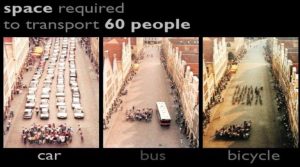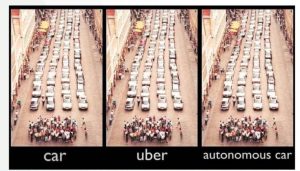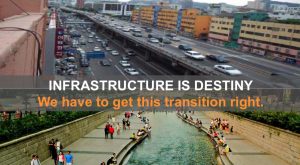These days we hearing about many things being delivered “as a service.” Recently, I got to moderate two days of discussions about mobility as a service.
Sometimes called
transportation as a service, the concept is an interesting one — as its core, it would reorient transportation around getting people from place to place, but opens up other modes of transportation above and beyond the car. Transportation consultant
Jack Opiola had the best definition that I heard: “Mobility as a Service (MaaS) is the seamless, infinitely adaptable delivery of mobility, together with associated travel information, necessary ticketing and payment services, across all modes of transport.”

An often used image that demonstrates the challenges facing transportation (h/t Robin Chase)
Why it matters: If you live anyplace where people want to live, transportation is difficult at best, and that’s on a good day. We are all impacted by it… and talk about it… and grouse about it. But it is such a unique eco-structure — EVERYBODY has an opinion on it… it is very political… and there is a ton of ‘why don’t they just…’ Furthermore, government is only one player among many players. But there are also broader impacts — on the Earth… on our bodies as we spend hours sitting in vehicles.
Some takeaways from the MaaS conference:
Transportation isn’t easy — This was my digest take away — transportation is just SO complex. One of the biggest challenges is… well, us… us and our cars. We love them. And we seem to be addicted to them… and sitting alone in them, seemingly regardless of how long it takes. It is the primary ways most people in the US get from point A to point B. But there are all other kinds of modes of transportation — bicycles, ride sharing/taxi-hailing apps, scooters, pedestrians, transit like bus and rail. There are multitudes of options, but in the end, government organizations only control a portion of those methods. Therefore there is a real need for different organizations to work together.
The challenges are real — One of the main discussion topics in any urban area is the commute. Roads are congested. This is particularly true in cities. While there is general agreement that new roads simply don’t solve transportation problems, for cities, in many cases, building new roads isn’t an option. Cities are also constrained because there simply isn’t space to construct new roads. Beyond that, the car has been detrimental to our health (Forget sitting at your desk — what about sitting in your car?) Not to mention the health of the planet… and all that wasted productivity. (Robin Chase, one of the founders of ZipCar, said,
“The car dominated city has reached its zenith.”)
The government is part of the mix, but there are a lot of players — A lot of transit is governed by a government organization, but there are so many players — drivers, bikers, engineers, politicians. (There was much discussion of European models where there is a goal — spoken or unspoken — of eliminating the need for cars. Call me skeptical but it is hard for me to imagine that in the US… Worth watching —
Atlanta has created a regional transportation authority — ATL — that is meant to pull the desperate government pieces together. There will definitely be lessons from the ATL experience.
The opportunities feel real — There does feel like an alignment of planets where changes can happen. And you are seeing it happen already around the world — even here in the US where there are people who are shifting to cities because they don’t want to own a car — and these days, they have options… many options. And we have seen change coming faster than we ever imagined. Who would have guessed the spread of “ridesharing” or taxi-hailing apps like Uber and Lyft would become so ubiquitous so quickly — and so utterly disrupt the taxi industry? Jack Opiola, Transportation Consultant noted the idea seemed unthinkable not long ago, but times have changed, often in ways that none of us could have predicted.

Driverless cars — heaven, or hell? h/t Dr. Kari Watkins
Driverless cars could be heaven – or hell — Everybody is watching what comes of driverless cards. Among these transportation experts, there was a general assumption that is will be here — and sooner than we think. But there is the very real possibility that, if truly driverless cars become a reality, then the roads could be packed with even more vehicles — and people who don’t care how long their commute takes because they are able to work in their self-driven car.
First mile – last mile — One of the real challenges is what transportation experts call the “first mile – last mile” — that is how does one get from “point A” to their transportation — and from where the transportation method drops a person off to get to “point B.”
Bottom line: Wow! The world is changing — and fast.
Presentations that I found particularly thought-provoking:








Leave a Reply
You must be logged in to post a comment.